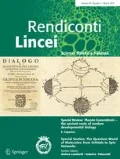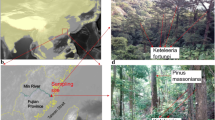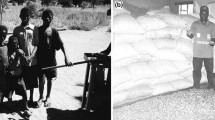Abstract
We assessed seven decades of change in the largest known population of the endangered endemic Boswellia elongata Balf. F. (Burseraceae) on Socotra Island (Yemen). To quantify the population change we evaluated tree number and locations on digitized images from various sources in the period 1956–2017 and combined this with direct field measurements of the population between 2011 and 2017. Our study reveals that the Homhil Nature Sanctuary B. elongata population shows a continuous decline since 1956. The steady but slow natural decline was strongly accelerated by two catastrophic cyclones in November 2015, when 38% of the trees were directly destroyed by strong winds. During the following 2 years 29% of the remaining trees died additionally. The remaining population has a bell-shaped size distribution; most trees are around 40 cm in diameter (range 18 to 70 cm). Tree ring analysis of 11 dead trees with a diameter of 29 to 44 cm without bark, resulted in estimated tree ages between 80 and 101 years. We estimate that similar-sized trees showing strong signs of senescence have a maximum age of a little over 100 years. The age structure of the Homhil population is, therefore, unbalanced with large sized trees prevailing. Natural regeneration is absent for decades. Viable seeds are available and have been shown to germinate, but the development of seedlings into saplings is a bottleneck. If the decline continues at the current rate, only 30 trees will remain there in 2036. Protection, planting and awareness activities are needed to keep this unique frankincense tree in Homhil Nature Sanctuary.




Similar content being viewed by others
Availability of data and material
Data are available on request from the authors.
Code availability
ArcGIS 10.55 Mendel University Licence—indica.mendelu.cz:27000.
References
Adolt R, Pavliš J (2004) Age structure and growth of Dracaena cinnabari populations on Socotra. Trees 18:43–53. https://doi.org/10.1007/s00468-003-0279-6
Adolt R, Buček A, Culek M, Habrová H, Klvač P, Koblížek J, Král K, Maděra P, Pavliš J (2004) Ecological network creation and agroforestry, educational and cultural starting points of sustainable development of Socotra Island. Project final report, Mendel University in Brno, Czech Republic
Attore F, Taleb N, De Sanctis M, Farcomeni A, Guillet A, Vitale M (2011) Developing conservation strategies for endemic tree species when faced with time and data constraints: Boswellia spp. on Socotra (Yemen). Biodivers Conserv 20:1483–1499. https://doi.org/10.1007/s10531-011-0039-7
Bongers F, Tennigkeit T (eds.) (2010) Degraded forests in Eastern Africa: management and restoration. The Eartscan Forest Library. https://doi.org/10.4324/9781849776400
Bongers F, Groenendijk P, Bekele T, Birhane E et al (2019) Frankincense in peril. Nat Sustain 2:602–610. https://doi.org/10.1038/s41893-019-0322-2
Bouget Ch, Duelli P (2004) The effects of windthrow on forest insect communities: a literature review. Biol Conserv 118:281–299. https://doi.org/10.1016/j.biocon.2003.09.009
Brendler T, Brinckmann JA, Schippmann U (2018) Sustainable supply, a foundation for natural product development: the case of Indian frankincense (Boswellia serrata Roxb. ex Colebr.). J Ethnopharmacol 225:279–286
Brienen RJ, Zuidema PA (2005) Relating tree growth to rainfall in Bolivian rain forests: a test for six species using tree ring analysis. Oecologia 146(1):1–12. https://doi.org/10.1007/s00442-005-0160-y
Brown G, Mies BA (2012) Vegetation ecology of Socotra. Springer, Dordrecht
Clarke S H (1935) The structure of the wood of Ash. Princes Risborough Dep Sci Ind Res For Prod Res Labor Proj 9 Prog
Efron B (1988) Logistic regression, survival analysis, and the Kaplan-Meier curve. J Am Stat Assoc 83(402):414–425
Ellis JE, Swift DM (1988) Stability of African pastoral ecosystems: alternate paradigms and implications for development. J Range Manage 41:450–459
Eltahir EAB (2011) Desert cloud forests: adapting a unique ecosystem to climate change. Working draft. Program on Forests (PROFOR), Washington DC
Eriksson M (2007) The bark beetle Ips typographus (L.) on patches of dead or dying host trees. Estimating the colonization success and the risk of consequential tree deaths. Dissertation, University of Joensuu
Eshete A, Sterck FJ, Bongers F (2012a) Frankincense production is determined by tree size and tapping frequency and intensity. For Ecol Manag. 274:136–142. https://doi.org/10.1016/j.foreco.2012.02.024
Eshete A, Teketay D, Lemenih M, Bongers F (2012b) Effects of resin tapping and tree size on the purity, germination and storage behavior of Boswellia papyrifera (Del.) Hochst. seeds from Metema District, northwestern Ethiopia. For Ecol Manag. 269:31–36. https://doi.org/10.1016/j.foreco.2011.12.049
Eslemieh J (2011) Cultivation of Boswellia: sacred trees of frankincense, A Book’s Mind. Phoenix, Arizona
Farah MH (2008) Non-timber forest productin (NTFP) extraction in arid envirronments: land-use change, frankincense production and the sustainability of Boswellia sacra in Dhofar (Oman). University of Arizona, Disertation
Fichtler E, Clark A, Worbes M (2003) Age and long-term growth of trees in an old growth tropical rain forest, based on analyses of tree rings and C-14. Biotropica 35:306–317. https://doi.org/10.1111/j.1744-7429.2003.tb00585.x
Gebrehiwot K, Muys B, Haile M, Mitloehner R (2003a) Introducing Boswellia papyrifera (Del.) Hochst and its non-timber forest product, frankincense. Int For Rev. 5:348–353. https://doi.org/10.1505/IFOR.5.4.348.22661
Gebrehiwot K, Muys FB, Haile M, Mitloehner R (2003b) Introducing Boswellia papyrifera (Del) Hochst and its non-timber forest product, frankincense. Int For Rev 5(4):348–353. https://doi.org/10.1505/IFOR.5.4.348.22661
Government of India, Ministry of Earth Sciences, Earth system science organisation, India Meteorological Department (2015a) Extremely severe cyclonic storm “Chapala” over the Arabian Sea (28 Octobe–4 November 2015): a report
Government of India, Ministry of Earth Sciences, Earth system science organisation, India Meteorological Department (2015b) Extremly Severe Cyclonic Storm “Megh” over the Arabian Sea (05-10 November 2015): a report
Groenendijk P, Eshete A, Sterck FJ, Zuidema PA, Bongers F (2012) Limitations to sustainable frankincense production: blocked regeneration, high adult mortality and declining populations. J. Appl. Ecol. 49(1):164–173. https://doi.org/10.1111/j.1365-2664.2011.02078.x
Groom N (1981) Frankincense and myrrh: A study of the Arabian incense trade. Longman Beirut
Gupta S (2007) Frankincense in the ‘triangular’ Indo-Arabian-Roman aromatics trade. In: Peacock D, Williams D, Bird J (eds) Food of the gods: new light on the ancient incence trade. Oxbow, Oxford, pp 112–121
Habrová H, Pavliš J (2017) Dynamic response of woody vegetation on fencing protection in semi-arid areas; Case study: pilot exclosure on the Firmihin Plateau, Socotra island. Saudi J. Biol. Sci. 24(2):338–346. https://doi.org/10.1016/j.sjbs.2015.09.030
Habrová H, Čermák Z, Pavliš J (2009) Dragon’s blood tree-Threatened by overmaturity, not by extinction: dynamics of a Dracaena cinnabari woodland in the mountains of Soqotra. Biol Conserv 142:772–778. https://doi.org/10.1016/j.biocon.2008.12.022
Harcombe PA (1987) Tree life tables. Bioscience 37(8):557–568. https://doi.org/10.2307/1310666
Hildebrandt A, Eltahir EAB (2006) Forest on the edge: seasonal cloud forest in Oman creates its own ecological niche. Geophys Res Lett 33(11):L11401. https://doi.org/10.1029/2006GL026022
Hildebrandt A, Eltahir EAB (2008) Using a horizontal precipitation model to investigate the role of turbulent cloud deposition in survival of a seasonal cloud forest in Dhofar. J Geophys Res 13:1–11. https://doi.org/10.1029/2008JG000727
Hildebrandt A, Al Aufi M, Amerjeed M, Shammas M, Eltahir EAB (2007) Ecohydrology of a seasonal cloud forest in Dhofar: 1. Field experiment. Water Resour Res 43:W10411. https://doi.org/10.1029/2006WR005261
Inc StatSoft (2013) Electronic statistics textbook. StatSoft, Tulsa
IUCN (2020) The IUCN Red List of Threatened Species. Version 2020-1. https://www.iucnredlist.org
Jensen Van Rensburg J, Hopper K (2017) Incense and imagery: mapping agricultural and water management systems on the island of Socotra, Yemen. Proc Semin Arab Stud 47:129–138
Kalivodová H, Culek M, Čermák M, Maděra P, Habrová H (2020) Potential importance of Socotra dragon’s blood tree cloud forests and woodlands for capturing horizontal precipitation. Rend Fis Acc Lincei, in press
Knížek M (2012) A new Halystus species from Socotra Island (Coleoptera: curculionidae: scolytinae: Polygraphini). Acta Ent Mus Nat Pra. 52(2):511–516
Kürschner H, Hein P, Kilian N, Hubaishan MA (2006) Diversity and zonation of the forests and woodlands of the mountains of northern Socotra, Yemen. Englera 28:11–55
Lvončík S, Řepka R (2020) Boswellia socotrana: one or Two Taxa? Novon 28:17–23. https://doi.org/10.3417/2019427
Lvončík S, Maděra P, Volařík D, Vrškový B, Habrová H (2013) First proposal of seed regions for Frankincense Trees (Boswellia spp.) on Socotra island. J Landsc Ecol 6(3):35–45. https://doi.org/10.2478/jlecol-2014-0002
Maděra P, Paschová Z, Ansorgová A, Vrškov B, Lvončík S, Habrová H (2017) Volatile compounds in oleo-gum resin of Socotran species of Burseraceae. Acta Univ Mendel Brun 65(1):73–90. https://doi.org/10.11118/actaun201765010073
Maděra P, Habrová H, Šenfeldr M, Kholová I, Lvončík S, Ehrenbergerová L, Roth M, Nadezhdina N, Němec P, Rosenthal J, Pavliš J (2018) Growth dynamics of endemic Dracaena cinnabari Balf. f. of Socotra Island suggest essential elements for a conservation strategy. Biológia 74:339–349. https://doi.org/10.2478/s11756-018-0152-0
Maděra P, Volařík D, Patočka Z, Kalivodová H, Divín J, Rejžek M, Vybíral J, Lvončík S, Jeník D, Hanáček P, Saad AA, Vahalík P (2019) Sustainable land use management needed to conserve the dragon’s blood tree of socotra island, a vulnerable endemic umbrella species. Sustainability. https://doi.org/10.3390/su11133557
Maděra P, Forrest A, Hanáček P, Vahalík P, Gebauer R, Plichta R, Jupa R, Jensen Van Rensburg J, Morris M, Nadezhdina N, Vaníčková L, Jura-Morawiec J, Wiland-Szymańska J, Kalivodová H, Lengálová K, Rejžek M, Habrová H (2020) What we know and what we don´t know about dragon trees? Forests 11:236. https://doi.org/10.3390/f11020236
Malatesta L, Attorre F, Altobelli A, Adeeb A, De Sanctis M, Taleb NM, Scholte PT, Vitale M (2013) Vegetation mapping from high-resolution satellite images in the heterogeneous arid environments of Socotra Island (Yemen). J Appl Remote Sens 7:073527
Marzol VM, Sánchez JL, Yanes A (2011) Meteorological patterns and fog water collection in Morocco and the Canary Islands. Erdkunde 65:291–303. https://doi.org/10.3112/erdkunde.2011.03.06
Mengistu T, Sterck FJ, Anten NPR, Bongers F (2012) Frankincense tapping reduced photosynthetic carbon gain in Boswellia papyrifera (Burseraceae) trees. For Ecol Manag 278:1–8. https://doi.org/10.1016/j.foreco.2012.04.029
Mies BA, Beyhl FE (1998) The vegetation ecology of Soqotra. In: Dumont H (ed) Conservation and sustainable use of biodiversity of Sogotra Archipelago. Proceedings of the first international symposium on Soqotra Island: Present and future, Aden, March 1996. UNE/GEF Publications, New York, Techn. Ser. Vol. 1, pp 35–81
Mies B, Lavranos J, James G (2000) Frankincense on Socotra Island (Boswellia, Burseraceae, Yemen). Cact Succ J 5:265–278
Miller A (2004) Boswellia. The IUCN Red List of Threatened Species 2004. https://www.iucnredlist.org/search?query=boswellia&searchType=species (assessed on 9.6.2020)
Miller A (2004) Boswellia elongata, The IUCN Red List of Threatened Species e. http://IUCN.UK.2004.RLTS.T30415A9546667.en
Miller A, Morris M (2004) Ethnoflora of the Socotra Archipelago. Royal Botanic Garden, Edinburgh
Mokria MM, Tolera FJ, Sterck A, Gebrekirstos F, Bongers M, Decuyper U, Sass-Klaassen (2017) The frankincense tree Boswellia neglecta reveals high potential for restoration of woodlands in the Horn of Africa. Forest Ecol Manag 385:16–24. https://doi.org/10.1016/j.foreco.2016.11.020
Morris MJ (2002) Manual of traditional land use in the Soqotra Archipelago. G.E.F.YEM/96/G32. Royal Botanic Garden, Edinburgh
Namdeo RK, Prasad R, Chaubey OP (1989) Impact of grazing-closure on some ecological aspects of Sal (Shorea robusta Roxb) natural forest with special reference to its natural regeneration in Madhya Pradesh. J Trop For Sci. 5(2):82–85
Negussie A, Aerts R, Gebrehiwot K, Muys B (2008) Seedling mortality causes recruitment limitation of Boswellia papyrifera in northern Ethiopia. J Arid Environ 72(4):378–383. https://doi.org/10.1016/j.jaridenv.2007.06.009
Ogbazghi W (2001) The distribution and regeneration of Boswellia papyrifera (Del.) Hochst. in Eritrea. Thesis, Wageningen University, The Netherlands
Ogbazghi W, Bongers F, Rijkers T, Wessel M (2006) Population structure and morphology of the frankincense tree Boswellia papyrifera along an altitude gradient in Eritrea. J Drylands 1(1):85–94
Pietsch D, Morris M (2010) Modern and ancient knowledge of conserving soils in Socotra Island, Yemen. In: Zdruli P et al. (eds) Degradation and desertification: assessment, mitigation and remediation. Springer Science and Business Media B.V., pp 375-386
Priya P, Bhat K (1998) False ring formation in teak (Tectona grandis Lf) and the influence of environmental factors. For Ecol Manag. 108:215–222
Read H (2000) Veteran trees: a guide to good management. English nature. The Countryside Agency and English Heritage, Peterborough
Rejžek M, Svátek M, Šebesta J, Adolt R, Maděra P, Matula R (2016) Loss of a single tree species will lead to an overall decline in plant diversity: effect of Dracaena cinnabari Balf. f. on the vegetation of Socotra Island. Biol Conserv 196:165–172. https://doi.org/10.1016/j.biocon.2016.02.016
Riccardi T, Malatesta L, Van Damme K, Suleiman AS, Farcomeni A, Rezende M, Vahalík P, Attorre F (2020) Environmental factors and human activity as drivers of tree cover and density on the Island of Socotra. Rend Fis Acc Lincei, Yemen. https://doi.org/10.1007/s12210-020-00923-9
Rijkers T, Ogbazghi W, Wessel M, Bongers F (2006) The effect of tapping for frankincense on sexual reproduction in Boswellia papyrifera. J Appl Ecol 43:1188–1195. https://doi.org/10.1111/j.1365-2664.2006.01215.x
Scholte P, De Geest P (2010) The climate of Socotra Island (Yemen): a first-time assessment of the timing of the monsoon wind reversal and its influence on precipitation and vegetation patterns. J Arid Environ 74:1507–1515. https://doi.org/10.1016/j.jaridenv.2010.05.017
Schroeder L (2001) Tree Mortality by the Bark Beetle Ips typographus (L.) in storm-disturbed stands. J Integr Pest Manag 6:169–175. https://doi.org/10.1023/A:1025771318285
Shiferaw A, Maděra P, Pavliš J (2020) Soil temperature in an open site and below two plantation forest canopies in a tropical highland area, southern Ethiopia. Theor Appl Climatol 139:907–914. https://doi.org/10.1007/s00704-019-03031-3
Thulin M (2020) The Genus Boswellia (Burseraceae): the frankincense trees. Acta Univ Upsalensis, Uppsala, p 2020
Thulin M, Carlo A, Johnson SP (2019) Boswellia occulta (Burseraceae) a new species of frankincense tree from Somalia (Somaliland). Phytotaxa 394(3):219–224. https://doi.org/10.11646/phytotaxa.394.3.3
Tolera M, Sass-Klaassen U, Eshete A, Bongers F, Sterck F (2013) Frankincense tree recruitment failed over the past half century. For Ecol Manag 304:65–72. https://doi.org/10.1016/j.foreco.2013.04.036
UNDP/GEF (2000) Socotra biodiversity project YEM/96/G32. Conservation zoning plan of Socotra Island. Presidental Decree no. 275
Van Damme K, Banfield L (2011) Past and present human impacts on the biodiversity of Socotra Island (Yemen): implications for future conservation. Zool Middle East 54(3):31–88. https://doi.org/10.1080/09397140.2011.10648899
Vetaas R (1993) Spatial and temporal vegetation changes along a moisture gradient in Northeastern Sudan. Biotropica 25(2):164–175. https://doi.org/10.2307/2389180
Worbes M (2002) One hundred years of tree ring research in the tropics—a brief history and an outlook to future challenges. Dendrochronologia 20(1–2):217–231. https://doi.org/10.1078/1125-7865-00018
Acknowledgements
We would like to thank the Franklinia Foundation, Boswellia the Czech Development Agency and partly UNE for supporting our research.
Funding
This work was supported by the Franklinia Foundation (2020-03) "Conservation of the endangered endemic Boswellia trees on Socotra Island (Yemen)", by the Czech Development Agency Project "Support of quality of high education in the Socotra province" (ID 22/2015/10) and partly supported by the UNE project "Support to the Integrated Programme for the Conservation and Development of Socotra Archipelago" (ID UNEP-GEF #5347).
Author information
Authors and Affiliations
Corresponding author
Ethics declarations
Conflict of interest
All authors declare that they have no conflict of interest.
Additional information
Publisher's Note
Springer Nature remains neutral with regard to jurisdictional claims in published maps and institutional affiliations.
This paper belongs to a Topical Collection “Twenty years of biodiversity research and nature conservation in the Socotra Archipelago” edited by Fabio Attorre and Kay Van Damme, conceived at the 18th Friends of Socotra Conference, 26–29 September, 2019, Orto Botanico di Palermo, Palermo, Italy”.
Rights and permissions
About this article
Cite this article
Lvončík, S., Vahalík, P., Bongers, F. et al. Development of a population of Boswellia elongata Balf. F. in Homhil nature sanctuary, Socotra island (Yemen). Rend. Fis. Acc. Lincei 31, 747–759 (2020). https://doi.org/10.1007/s12210-020-00936-4
Received:
Accepted:
Published:
Issue Date:
DOI: https://doi.org/10.1007/s12210-020-00936-4




